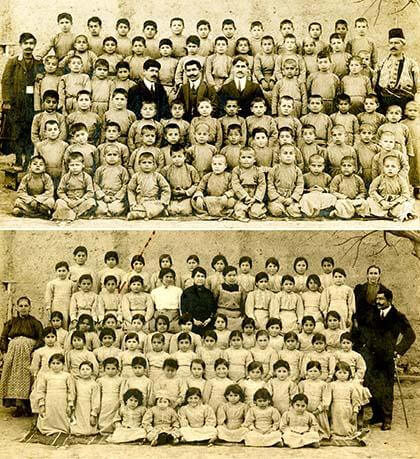By Rich Bockmann
The U.S. government does not officially recognize the Armenian Genocide, but a new exhibition at Queens College has been curated with the intent of preserving the memories of the 1.5 million who lost their lives during the first genocide of the 20th century.
“Genocide: The Armenians 1915-1922” consists of posters, books and photos from the personal collection of Hratch Zadoian, a professor of political science at the college. Zadoian was born in Romania to Armenian parents.
Curator Evelyn Leahy, a native Armenian, called Zadoian a great storyteller and said the collection reveals a wealth of historical information and personal accounts that will astound even those who are familiar with the genocide.
“I suppose it was the first time when my professional venture became closely intertwined with a very personal sentiment,” she said.
Zadoian said the Armenians had been living for a couple of millennia in what at the time was the Ottoman Empire. They represented a Christian minority and tensions rose further when the Young Turks, a revolutionary group, came to power in the Ottoman Empire in 1908.
Standing in front of the exhibition in the Barham Rotunda of the Rosenthal Library last week, Zadoian told the story of the beginning of World War I which presented the opportunity to for the Young Turks to “deal with the Armenian problem.”
“April 24, 1915, several hundred community leaders, intellectuals and members of Parliament were arrested and all killed. What begins is a set path of extermination of 250,000 or so Armenians in the Ottoman army. They were segregated into labor battalions and killed,” he said.
Zadoian said the army then moved onto population centers such as Sepastia and Bitlis in present-day Turkey and Der-el-Zorn in present-day Syria, decimating the Armenian peoples there.
“As in other genocides, the women suffer the most,” he said.
The documents of the exhibition include historical documents, such as a revised Bryce Report. James Bryce was appointed by the British government to write a report on the atrocities committed against the Armenians, which redacted the names of the victims. The revised report includes those names.
There are several posters commissioned by Near East Relief, the organization set up in 1915 at the urging of the U.S. ambassador to the Ottoman Empire in order to raise funds to assist the Armenians.
“There are generations of Armenians alive today because of Near East Relief,” Zadoian said.
On the more personal side, there is a picture of Zadoian’s father, Vartan, in 1920 in Turkey standing alongside the school of orphans he helped save. Between 1918 and 1922, he crisscrossed the Middle East rescuing and paying ransom for Armenian orphans.
Zadoian told an anecdote of his parents fleeing to Romania where they were wed: “On the night of their wedding, many youngsters came in calling [Vartan] ‘father.’ My mother was taken back!”
The professor said he is currently working on making the permanent collection at Queens College the premier academic resource on Armenian subjects.
“One of the greatest fears of people who died in genocide is no one will know. No one will remember,” he said. “The community should get a sense of satisfaction that the denial has not worked. The world knows.”
Reach reporter Rich Bockmann by e-mail at rbockmann@cnglocal.com or by phone at 718-260-4574.
































